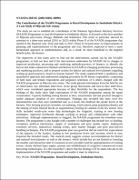| dc.description.abstract | NTANDA IRENE (2008-M092-20090)
The Contribution of the NAADS Programme to Rural Development in Sembabule District: A Case Study of Mijwala Sub-county.
The study set out to establish the contribution of the National Agricultural Advisory Services (NAADS) Programme to rural development in Sembabule district. It focused on the three parishes of Mijwala sub-county (Nsoga, Mabindo and Kidokolo). This study in particular skewed its attention to a three-year period (2010 to 2013) within Phase II of the NAADS programme that started in the financial year 2010 and ends in 2015. Phase II focused more on improvements in planning and implementation of the programme and was, therefore, expected to have a more harmonised approach to implementation and, as a result, be more beneficial to the targeted beneficiaries; the farmers.
The objectives of this study were to find out the interventions carried out by the NAADS programme; to find out how and if the interventions undertaken by NAADS led to changes in improved production, processing and marketing methods/practices of farmers; to identify the factors that either enhanced or limited contribution by NAADS in changing production, processing and marketing practices; and to propose actions for district and national level planners regarding scaling-up good practices, based on lessons learned. The study employed both a qualitative and quantitative approach and randomised sampling procedure for 60 farmer respondents, comprising of both male and female respondents and purposive selections of 6 others charged with the NAADS programme in Mijwala sub-county. The study gleaned information from the field by use of observation, key informant interviews, focus group discussions and face-to-face interviews, which were considered appropriate because of their flexibility for the respondents. The key findings of this study show high expectations of the NAADS programme among the target communities. Capacity building among farmers is slow, unsystematic and not practical enough to enable adequate adoption of new technologies. Findings also revealed that there were few demonstration sites that were established and, as a result, this hindered the uptake levels of the farmers. New farming practices included, row planting, weed control, plant population density and the making of multi-mineral blocks as supplementary feeding for animals in the dry season. New skills included small-scale water drip technologies for irrigation, training in new farming techniques, improved livelihoods through working in groups and collaborations with other institutions. Although implementation is sluggish, the NAADS programme has benefited some farmers. The programme is also fraught with a number of challenges that include low co-funding, corruption, political interference, supply of inadequate and poor quality inputs, inadequate extension services, impractical training events, poor market linkages and poor post-harvest handling techniques. The NAADS programme plan was good but did not match the expectations of the majority of the farmers, leading to low production levels and incomes, which in turn, impacted the intended results. The research study suggests various recommendations for district and national level planners as well as the farmers, which include but are not limited to: boosting the number and interaction time of extension service providers and the appropriateness of training events, clearly defined input supply systems and establishment of irrigation schemes/rain-water harvesting technologies. It is the researcher‟s desire that the findings will be made relevant in the implementation of the NAADS programme and enable it meet its objectives.
Key Words: NAADS Programme, Rural Development, Sembabule District. | en_US |


